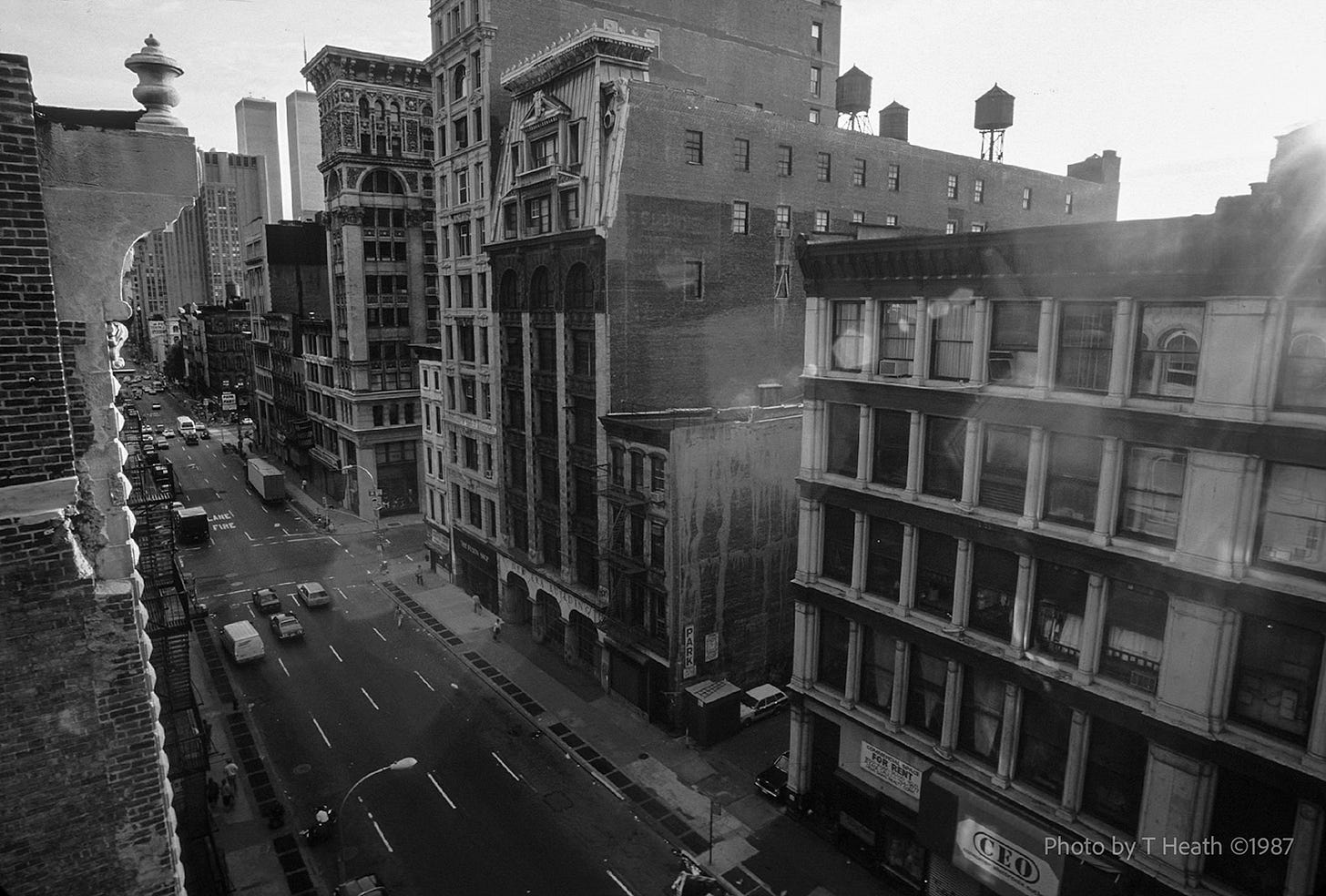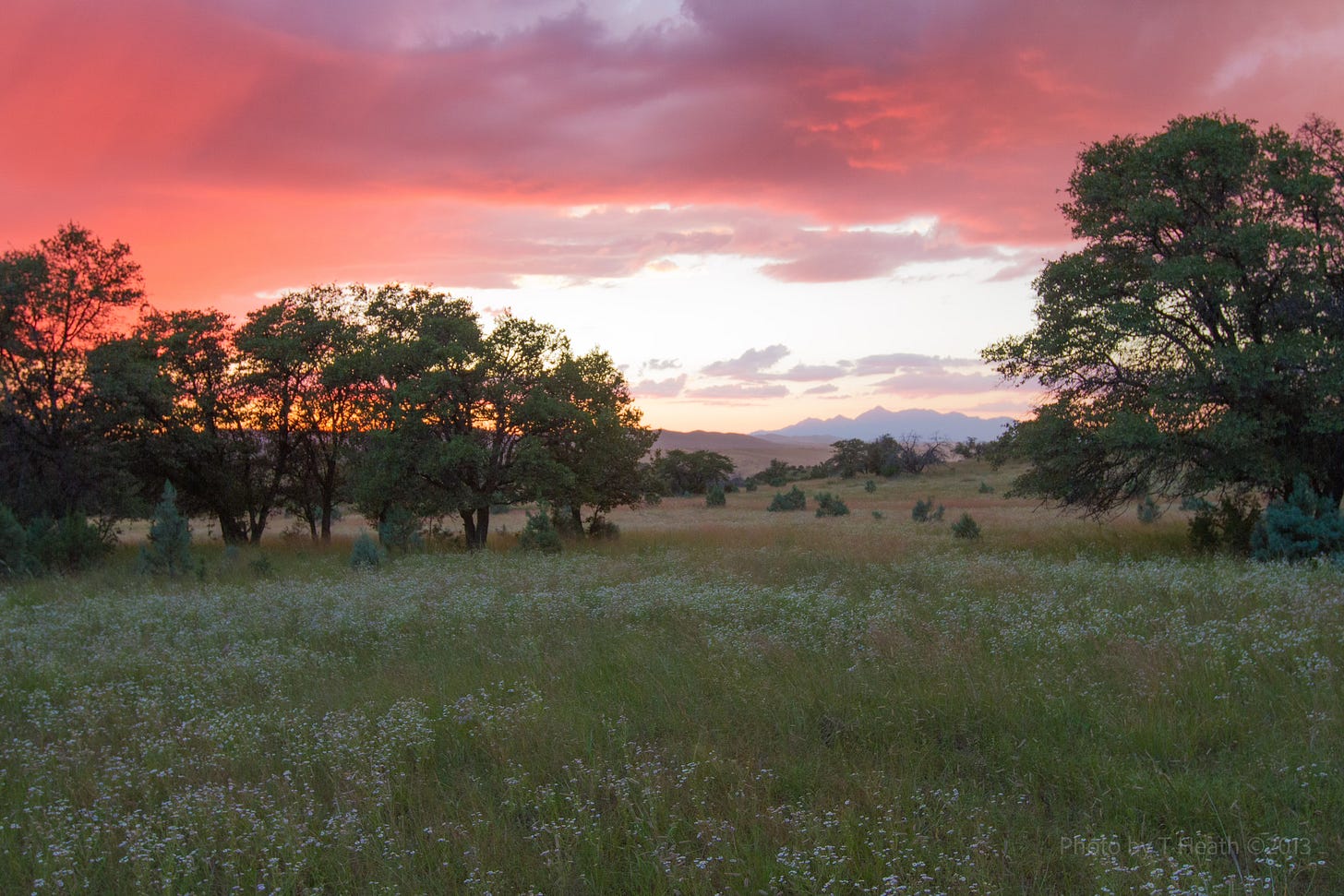When you get caught between the moon and New York City
I know it's crazy, but it's true
If you get caught between the moon and New York City
The best that you can do (The best that you can do)
The best that you can do
Is fall in love1
Return to The Streets
We arrived home in the January of my forty-third year jetting in over Manhattan on a flight from Tucson.
The bloated Airbus made a dramatic pass over my emerald city. Lower Broadway twinkled with the lights of taxis, tiny yellow bodies moving through the glittering light and ochre smog. A saturation of photons sprayed us—up through the ether at the speed of light—as we banked right into La Guardia.
We had missed a grand snowstorm, but it was gone now and the streets had turned back to gray.
In the intimacy of my holiday walkman, I gazed into the mystery of the glowing island below my window. Ben Webster’s gentle whir comforted me as my anticipation grew to anxiety. The view both excited and repulsed me, spellbound by Ben’s jazz and the sight of those gilded canyons gliding by at three hundred miles an hour. Fixed on a point, my eye measured our progress along the northbound avenues.
Packed with lives, the galactic immensity of which no human brain could fathom, New York suddenly seemed a place every human life on Earth wanted to be—the mothership of competition—beings stacked on top of one another in buildings scraping the skies for miles in all directions. The mathematics of it was daunting beyond imagination. Would the Earth stand still and the sirens sound?
I thought to myself, “Cat, you don’t need this, to be here at this epicenter-of-ambition, one stoic face in an immense and endless crowd.”
Domestic Life
I’d had an allergy to it for too long; to the cacophony of it all; of everything in one place all at once. I’d imprisoned myself in this oversized postage stamp for too long. I knew it was blasphemy, but the world was promising me gifts elsewhere. The two sides, like devils, sat on my shoulder whispering in my ear and arguing amongst themselves.
I’d not been immune to it, struggling for something undefinable behind locked doors. Strife prowled the streets unchecked in search of victims. High art
was gradually being taken over by big business in search of the buck with the biggest rack.
The brouhaha was unbearable. “Is there any money in it?” “Can we make a deal?” “Do we have a deal?” “I thought we had a deal.” “Where’s the money?” “How much money?” “Has he got the money?” Can they raise the cash?” What’s the commission? Money... cash... money... downpayment... money!
In my white van with commercial plates and a sticker of a bluefish, I shuttled Robert De Niro Sr. and his paintings around for twelve dollars an hour under the auspices of “man with truck.”
Robert Earle Jones, father of James, hired me to move things too. I don’t know what it was about fathers. They just trusted me.
I advertised in the Village Voice. One morning a woman called and asked me
if I’d make love to her (forgo the moving...). “OK...? And now for something completely different,” I thought to myself. But that was not me, “wink, wink,
nod, nod. Say no more!”2
One time I went to jazz musician Howard Johnson’s loft where his bari lay peacefully on the couch like a seductress waiting for her queue: “Live from New York... it’s Saturday Night!” I delivered to Pharaoh Sander’s loft next to the Manhattan Bridge, and in mid-town Manhattan for Choice Messenger Systems. I delivered handmade harpsichords for “Buecker and Harpsichord” on West Broadway.
It was the beginning of a living.
The Hood
My teachers in art school had professed that if one started in New York City
one would always be a “New York artist,” wherever you ended up on the road of life. New York was the holy grail of every art school geek and free spirit longing to be a young master. But like everything in America, you had to have the money, but then you risked your peers hating you for it. New York was impossible, but the song said it all and we believed it, “If you can make it there, you can make
it anywhere.”3
In nineteen seventy-six, the proverbial Soho loft had come my way on lower Broadway. For thirty-five hundred I’d purchased the fixtures and lease for the second floor at 508 Broadway from sculptor Ken Greenleaf, years ahead of me on his way out to a sensible life.
Renovating a floor in a cast iron building was standard operating procedure for young Soho pioneers with shiny new BFAs. I blocked traffic on Broadway filling dumpsters with debris from eight ceilings built on top of each other over the decades. Next came new, insulated sheet rocked ceilings to muffle the sound of my music, and fresh oak strip flooring to replace the original floors cracked and split from years of heavy industry. Yards of BX cable ran through a birdcage of metal studs to create my Bauhaus-styled interior, complete with tiled bathroom and copper plumbing.
My building partners were dancers and filmmakers and painters, all of whom were absolutely sure they were on their way up. As the youngest, I was smitten. Joel Freedman and I did most of the work to buy the building. The others followed with their share of the down payment and a signature. If what my parent’s said was true, and there was no money in the arts, only a life of pain and regret, at least the real estate would make me rich when I clawed my way up the pyramid. I was in the right place at the right time.
Merry-Go-Round
At a giant party in Tribeca during my first months in Soho, I met Ruth, the third person in the wreck that killed Pollack. A man shook hands with me and said, “Hi, I’m Mel Bouchner.” I was naively starstruck and ready for the art world’s embrace. Everybody was a legend in their own mind.
I knew Mike Fanelli. I was stalked by a witch. I was a regular at Puffy’s and Magoo’s. I watched Phil Glass play pool at Magoo’s while I ate my pita burgers in solitude. Eight dollars brought me home at 4:30am stumbling up my stairs.
I was in and out of hundreds of “openings,” more than enough to make me
realize I was just one stranger in a strange land4 where even my friends from art school wouldn’t catch my eye. I was a vegan in a school of barracudas looking me up and down floating in a sea of pretension, speaking and acting completely different than me. Waitresses were uniformly obnoxious, but expected a tip. It wasn’t Kansas anymore.5 I was sure of that.
Against all odds, regiments of artists navigated the cunning deceit of those who would define what sold, and mandate to a mindless society exactly what was “good art” (the rest bad), and its rightful price, guaranteed high.
As the years passed, in no time it seemed my neighborhood changed from conceit to pomp as shops lined up for “space.” They wanted a piece of what they thought was hip because we were there. We invented the term, “bridge and tunnel crowd,” to describe aggregations of souls from Jersey and Long Island and other “normal places,” making the pilgrimage to Soho by the tens of thousands every Saturday and Sunday to shop and gawk.
Kate-bird
One morning when all seemed lost, I walked into my office on the top floor of
225 Lafayette where I’d been forced for a short time to flee with my tail between my legs, for that elusive of all, but essential commodities, money. I looked up and there she was. Serendipity had walked in with a positive attitude and a smile, wings hidden, but very much there.
“I’ve been sent to save Mr. Heath.” Nobody but me seemed to notice her.
“I’m forming a band and I’ll be playing in major clubs in sixty days and signed by the end of year.” My eyebrows stood on end. She’d jagged me.
Our first date at Mondo Cane Blues Bar ended with a tender peck. She moved in with me. Suddenly I was in love for the third time in my life. I’d been “caught between the moon and New York City,”6 and I’d make the best of it.
I became a “certified artist” by the City of New York, finally legally able to live in the building I owned for years.
I’d payed real dues. I’d hung out with Sonny Stitt at Beefsteak Charlie’s where he’d lectured me on the power of Jesus, we drank with Anita O’Day in her eighties, and lunched with Clark Terry holding court at South Street Seaport. Our band played Birdland and Metronome and the Five Spot.
Epilogue
That would have to be enough. After twenty-one years my angel and I were headed west down the “road to sun.”7 The public still owned land there.
Outrageous hubris had threatened to drown us; pompous conceit undermine us; the deliberate indifference of our peers emasculate us; the fickled-finger of perceived-excellence had frustrated us; the razor thin line between relevance and irrelevance flummoxed us.
We landed on a sky island in a vast desert, an idyllic place far from roar of the RR under Broadway, and the ever-present racket of the latest car alarms running absurdly through a litany of digital clatter society expected us to be tolerant of.
Imagine, two sweet New Yorkers, having done hard time in the city-of-ambition, and with something to show from those urbane canyons where the raindrops of failure and the smell of success hovered menacingly. We’d scaled the labyrinthine ravines of aspiration with thousands of others in the same cauldron of self-absorbtion. We’d learned, we’d grown, we’d prospered; we were satiated, and ready to escape from New York.
I’d hopped that freight before. The long light of the American West suited us.
Tony Heath is an artist, jazz musician, activist and aspiring writer of essays and fiction in Arizona. He and his wife, Kate Scott, co-founded a wildlife advocacy on their ranch in Cochise and Santa Cruz Counties.
Photographs by the author ©
Arthur’s Song (Best That You Can Do),” by Burt Bacharach and Carole Bayer Sager, sung by Christopher Cross.
Eric Idle, Monty Python
New York, New York, by Leonard Bernstein, Adolph Green and Betty Comden
Stranger in a Strange Land, by Robert A. Heinlein, 1961
The Wizard of Oz
Ibid, footnote 1
“Road to the Sun,” by Antonio Carlos Jobim






